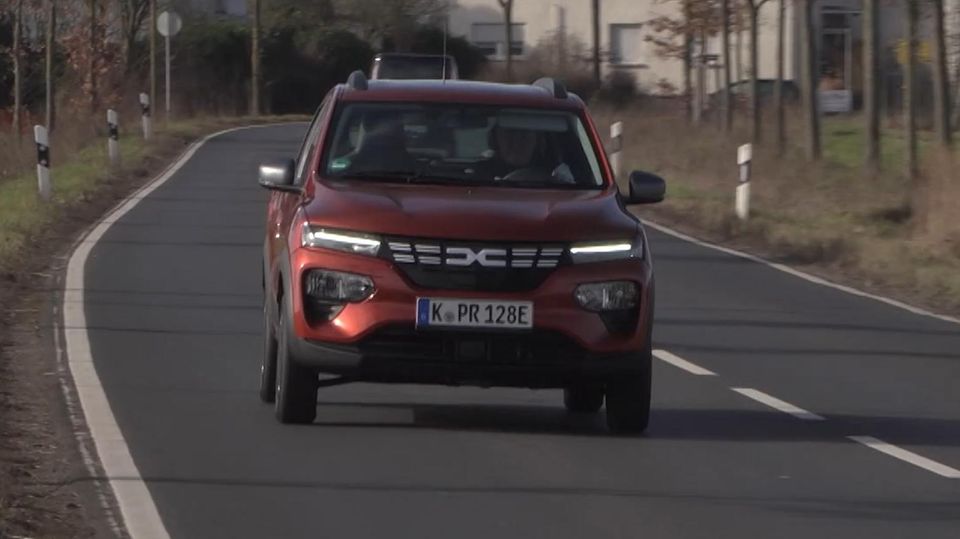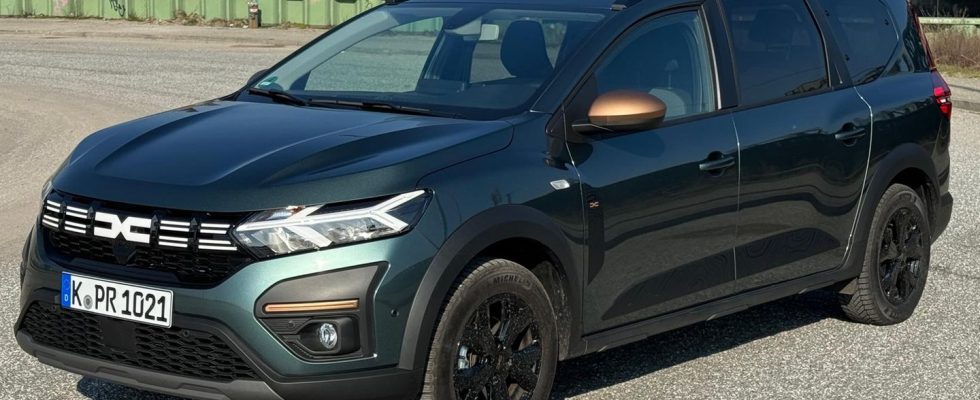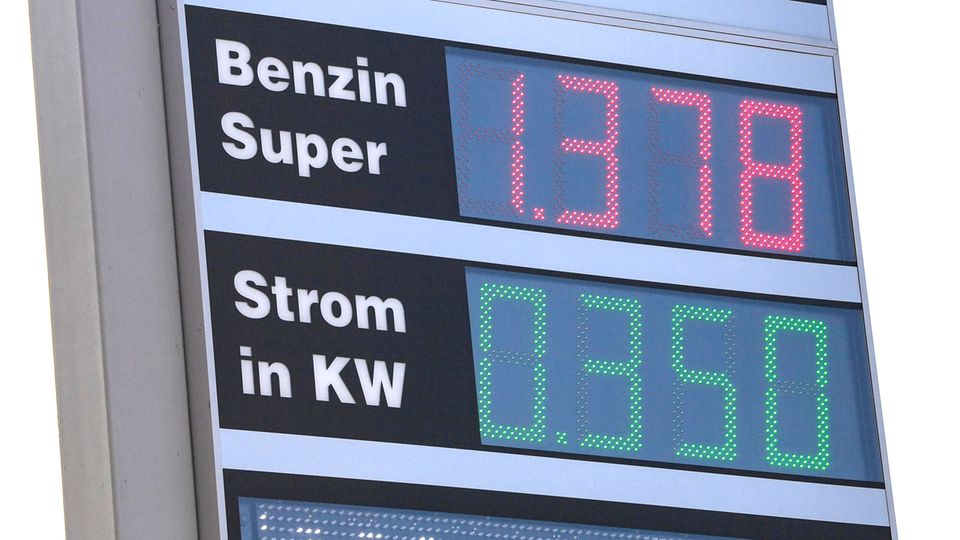Almost 30,000 euros is an unusually high amount of money for a Dacia – but the Jogger 140 Hybrid compact van also has a lot to offer. However, buyers cannot escape without compromises.
There is almost 10,000 euros between the currently cheapest Dacia Jogger (Essential TCe 100) and the test car star-Editorial staff. This vehicle is a Dacia Jogger 140 Hybrid Extreme – or in short: best equipment, most expensive drive. The Jogger 140 is a so-called full hybrid, which, thanks to the electric motor, can also function for long periods without support from the combustion engine. The addition “Extreme” means that Dacia includes extras such as a digital speedometer display, a reversing camera and a multimedia system with an 8-inch touchscreen and smartphone integration as standard. But does the “full cabin,” as people like to say about vehicles with maximum equipment, make the difference? Or are there places where Dacia lives up to its somewhat cheap reputation? Two weeks with the vehicle shed some light on the matter.
The first impression is surprising. Dacia has been relying on a revised design for around two years. This also applies to joggers. The new logo, the LED lights, the body: on the outside, the car looks anything but cheap; even a compact van looks fresh, young and dynamic with this appearance. It’s not that easy to pack a seven-seater fairly nicely. Vans are rarely a feast for the eyes. I like the jogger, especially in cedar green.
Dacia lives up to its reputation in the interior
Once you get in, you know why Dacia is in the car world what Kik is in the textile industry. You get a lot for your money, but you have to live with certain weaknesses in the product. This is particularly noticeable in the interior of the Dacia Jogger. Hard plastic as far as the eye can see. There are also decorative elements, but even they seem a bit cheap. This continues with the steering wheel and the screens. But the worst thing is the gear selector. It rarely happens that you can’t find neutral gear in a car and accidentally end up in R or D, but this happened several times with the jogger when you unconsciously pushed the button on the lever and insensitively stirred the switch box. Also quite bad: the cell phone holder on the middle display. It’s commendable that Dacia has installed one there, but you need a huge amount of faith in God to mount a smartphone there.
Hybrid
Dacia Jogger 140 Hybrid Extreme in pictures
That’s not to say that anything didn’t work. On the contrary: the car drives reliably, the technology works without any problems and you get from A to B safely. But it all feels very rustic, a bit base and almost too simple. A simple construction site vehicle only differs in the degree of contamination. The good news: In a car like this, everything doesn’t matter.
Five kids in the back seat spilling candy? Doesn’t matter. A sandy dog in the trunk giving itself a good shake? Doesn’t matter. Is there a scratch on the door panel when loading? That too: no matter. The Dacia gives the feeling that everything is fine and life goes on. You can drive this car incredibly calmly – almost like the first car, whose sole purpose was to experience the effect of brickwork and pavement when the vehicle comes into contact.
Where the equipment minimalism has a positive effect is in the cargo space. The vehicle can be converted in almost no time at all. The third row of seats consists of two individual seats that, with a little practice, can be removed from the car with just one movement. If you need it as a seat, you can simply fold it out. The second row is fixed, but can not only be folded down, but also folded completely forward to provide even more space. The loading space varies between a meager 160 liters and an extremely generous 1807 liters. In everyday life there is hardly a scenario where this is not enough. And if it does, there is always a trailer hitch that allows the jogger to pull up to 750 kilos with the brakes. A small note: However, the towing capacity of combustion engines is significantly higher.
Electrically great, circuitry poor
The rustic style of the Dacia Jogger also continues with the drive. When you switch on the hybrid, the electric motor hums in a relaxed manner. Until after a few meters the combustion engine signals itself and charges the battery. But it doesn’t do this subtly and quietly, but instead hums quite loudly and causes the entire car to vibrate. You almost breathe deeply when he finally calms down again.
This also applies to driving with the 94 hp combustion engine. As soon as the “EV” display on the speedometer goes out, it becomes loud. This happens, for example, when you accelerate too hard or the battery needs to be charged. The lack of additional insulation is immediately noticeable – it hums and booms. And on the motorway at speeds of 140 km/h or more, you can hardly understand a word from the radio. The riot concert is rounded off by the so-called multi-mode transmission. This basically consists of a four-speed automatic transmission for the combustion engine and a two-speed automatic transmission for the electric drive. When driving, however, this is not noticeable separately, but rather merges smoothly into one another. But: The automatic system works very inharmoniously overall and often revs very high before the desired switching process occurs. The sportier you drive, the louder and more chaotic it becomes. The Dacia actually only shows its best side in pure E mode. Under the influence of gasoline you might think that a student driver is sitting on the clutch.

Even though the engine howls noticeably often, it achieves top results at the pump. In mixed operation, i.e. approximately equal parts on the highway and in the city, the Jogger Hybrid achieved a consumption of 5.4 liters per 100 kilometers in the test. This is naturally more on the highway and correspondingly less in the city. The hybrid shows its full strength here. In conjunction with the 50 liter tank, a range of around 900 to 1000 kilometers can be expected. But: Due to the price premium, the purchase is actually only worthwhile if the routes are mainly in urban areas, ideally in cities with a lot of stop & go. Otherwise (i.e. in rural areas) the additional costs are unlikely to be amortized compared to a pure combustion engine.
The comfortable gondola suits the jogger best anyway – and the manufacturer doesn’t plan for a fast ride. At 167 km/h the end of the flagpole has already been reached. So you’re unlikely to see a jogger in the left lane. But no matter how fast, the Dacia never feels unsafe or uncontrollable. On the contrary: the steering and suspension work reliably in all areas.
Wonderfully quiet
When it comes to the jogger, we hear again and again that it only received one star out of five in the Euro NCAP crash test. However, this is less due to the fact that the car is unsafe for the occupants, but rather due to inadequate pedestrian protection and a lack of assistants, which are standard in most models today. This may even have advantages for drivers: Because the jogger lacks both traffic sign recognition and a fatigue warning system, the car doesn’t annoy you with constant beeping. Other manufacturers make their cars howl when you drive at 52 instead of 50 and the driver only looks to the side for a few seconds. This is for security, but sometimes it’s extremely annoying. In this regard, there is a heavenly calm in the Dacia.
Conclusion Dacia Jogger 140 Hybrid Extreme
The Dacia Jogger 140 Hybrid Extreme is a great car for what it is. And a huge car. The attractively packaged compact van didn’t have any major weaknesses in the test and is particularly impressive with its surprisingly well-rounded equipment and really good fuel consumption for such a large car.
The Romanians’ sharp pen is particularly noticeable in the interior, in the technology and accessories such as the cell phone holder. Everything is there, but it definitely comes from the suppliers’ discount shelves. Nevertheless, extras such as Apple’s Carplay are on board as standard, which is not only very useful, but, to be honest, also makes the on-board navigation system and on-board infotainment so irrelevant that Dacia could have simply left it out.
However, the Billo design, which is noticeable in places, has a huge advantage: nothing really hurts a Dacia. This car handles scratches, dirt and driving through deep mud puddles with a friendly shrug of the shoulders and conveys a certain attitude that doesn’t matter, which makes driving all the more relaxing. And if everything basically works and you have a lot of space – what more could you want?


